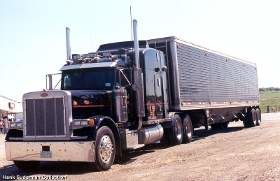H.O.S Need Help
Topic 6645 | Page 2

Thanks for the good input. I've struggled a little grasping the hos rules and effectively applying them. I think I finally get it! :D
HOS:
Hours Of Service
HOS refers to the logbook hours of service regulations.
That helps. So really, I could work everyday as long as my 8 day total is under 70 hours.
Exactly.
Keep in mind, that most drivers don't actually drive their 11 hours in a 14 hour day - between waiting at shippers/receivers/etc. But if you somehow WERE to actually get (for example) that 11 hours a day - for 6 days in a row - in the 7th day, you would only have 4 hours available to drive before you hit your 7- and have to sit.
This is also why drivers will usually go IMMEDIATELY to line 1 or 2 once they reach a destination. ALL HOURS from lines 3 & 4 count towards the 70 hour clock.
Now - "technically" - if you're if you've arrived at a shipper/receiver and you're waiting to get loaded/unloaded - you're supposed to be ON DUTY (not driving) and this affects your 70 hour clock. Most drivers will log that time as OFF DUTY or SLEEPER BERTH. You may spend 4-5 hours a day, waiting at/for a dock - you don't want to burn those up on your 70 hour clock.
This doesn't affect your 14 hour daily clock (unless you spend 8 continuous hours on line 2 - Sleeper Berth - then you get those 8 hours back). You still only have 14 hours from the time you come on duty, to drive your 11 hours.
If you're getting a lot of days in a row - with a lot of line 3 & 4 (On-Duty/Driving) time, you will soon get to a point where you DON'T HAVE a full 11 hours to drive in a day. You may only get 4-5 hours, and that doesn't get you very far. At that point - a 34 hour reset - will zero the clock.
Most guys hate to sit for that 34 hours - can't make $$ if the wheels aren't rolling. After awhile on the road - drivers get a feel for how to manage their clocks most effectively, so they don't have to do resets or be stuck without the required hours left to make pickups/deliveries on schedule.
It's confusing when you're first trying to get a grasp of it - but it becomes easier with time. Most companies are on ELECTRONIC LOGS now - so you can look at your day and weekly re-caps as they run.
Rick
Unless otherwise told by a shipper/reciever that you can leave the truck while they load you, you shouldn't log off duty. Off duty is for times when your aren't responsible for the truck. Shower, eating in side, 30 min break out of the truck, etc...
When I get to a customer, I will go from Driving (line 3) to On-Duty (Line 4) from the time i set my breaks to the time i get checked in. Once Im checked in I go straight to Sleeper (line 2) Once that light turns green on the dock, I'll go back to On-Duty, get my paperwork, send my loaded/empty call and go to Driving. This usely puts me at 10-15 min On-Duty which is plenty of time to check in, open doors and back into a dock.
When I stop for fuel, I'll go from line 3 to 4, fuel and then pull up from the pumps, drop to line 1 and go take care of my personal business.
Now there is another way to save all your time, and thats to arrive at a customers lot as early as possible so you can sneak a 10hr break in. Danial B talks about it a lot in his threads. You arrive the night before a pickup/delivery, get up in the morning and without touching your clocks get checked in get your dock get loaded and then once loaded and your ready to roll, do your pre-trip and start your clock then. If your arrive the night before, and you get in the next morning, you have know idea if its going to take 30min or 12hrs to load, so why start your clock? you can maximize your drive time by not starting your clock, if you happen to have to wait 6hrs to be loaded, then you can catch some zzz and once your loaded have a full 11 to run still. Hope this makes sense.
There are ways to "conserve" your hrs which is what you want.
Electronic Logs:
Electronic Onboard Recorder
Electronic Logbook
A device which records the amount of time a vehicle has been driven. If the vehicle is not being driven, the operator will manually input whether or not he/she is on duty or not.
Shipper:
The customer who is shipping the freight. This is where the driver will pick up a load and then deliver it to the receiver or consignee.
Sleeper Berth:
The portion of the tractor behind the seats which acts as the "living space" for the driver. It generally contains a bed (or bunk beds), cabinets, lights, temperature control knobs, and 12 volt plugs for power.
HOS:
Hours Of Service
HOS refers to the logbook hours of service regulations.It seems most people look to where they've been in hours ("I can only drive five ours today then I bump into my 70 hour limit.") Daniel B. has written a blog of one month of OTR in Western States. But, when you read the entries, you learn about strategy of time management. Daniel's month (December, 2014) is a treasure trove of things They Don't Teach You In School.
A month of trucking with Daniel B.
OTR:
Over The Road
OTR driving normally means you'll be hauling freight to various customers throughout your company's hauling region. It often entails being gone from home for two to three weeks at a time.

I am not sure where people heard that the 1am to 5am and 168 hr restrictions were suspended. Please read below
395.3: Maximum driving time for property-carrying vehicles.
(a) Except as otherwise provided in § 395.1, no motor carrier shall permit or require any driver used by it to drive a property-carrying commercial motor vehicle , nor shall any such driver drive a property-carrying commercial motor vehicle, regardless of the number of motor carriers using the driver's services, unless the driver complies with the following requirements:
(1) Start of work shift. A driver may not drive without first taking 10 consecutive hours off duty;
(2) 14-hour period. A driver may drive only during a period of 14 consecutive hours after coming on duty following 10 consecutive hours off duty. The driver may not drive after the end of the 14-consecutive-hour period without first taking 10 consecutive hours off duty.
(3) Driving time and rest breaks. (i) Driving time. A driver may drive a total of 11 hours during the 14-hour period specified in paragraph (a)(2) of this section.
(ii) Rest breaks. Except for drivers who qualify for either of the short-haul exceptions in § 395.1(e)(1) or (2), driving is not permitted if more than 8 hours have passed since the end of the driver's last off-duty or sleeper-berth period of at least 30 minutes.
(b) No motor carrier shall permit or require a driver of a property-carrying commercial motor vehicle to drive, nor shall any driver drive a property-carrying commercial motor vehicle, regardless of the number of motor carriers using the driver's services, for any period after—
(1) Having been on duty 60 hours in any period of 7 consecutive days if the employing motor carrier does not operate commercial motor vehicles every day of the week; or
(2) Having been on duty 70 hours in any period of 8 consecutive days if the employing motor carrier operates commercial motor vehicles every day of the week.
(c)(1) Any period of 7 consecutive days may end with the beginning of an off-duty period of 34 or more consecutive hours that includes two periods from 1:00 a.m. to 5:00 a.m.
(2) Any period of 8 consecutive days may end with the beginning of an off-duty period of 34 or more consecutive hours that includes two periods from 1:00 a.m. to 5:00 a.m.
(d) A driver may not take an off-duty period allowed by paragraph (c) of this section to restart the calculation of 60 hours in 7 consecutive days or 70 hours in 8 consecutive days until 168 or more consecutive hours have passed since the beginning of the last such off-duty period. When a driver takes more than one off-duty period of 34 or more consecutive hours within a period of 168 consecutive hours, he or she must indicate in the Remarks section of the record of duty status which such off-duty period is being used to restart the calculation of 60 hours in 7 consecutive days or 70 hours in 8 consecutive days.
Citation: [76 FR 81188, Dec. 27, 2011, as amended at 78 FR 58485, Sept. 24, 2013; 78 FR 64181, Oct. 28, 2013]
Commercial Motor Vehicle:
A commercial motor vehicle is any vehicle used in commerce to transport passengers or property with either:
- A gross vehicle weight rating of 26,001 pounds or more
- A gross combination weight rating of 26,001 pounds or more which includes a towed unit with a gross vehicle weight rating of more than 10,000 pounds
OWI:
Operating While Intoxicated



Before 2013 the rule was you could take your 34hr reset at any period, then in July of 2013 they changed the rules, 2 consecutive periods between 1am and 5am and could only do a reset after 160hrs . So basically every 6.75 days. They also issued the 8hr break rule which doesn't change.
I'm still confused. Do you reset only if you hit 70 hours in the 8 day period?
My current status says it all. I was back from home time two days ago(34 hrs reset done), picked up a load and drove all the way to Idaho, now I'm waiting for appointment time on tomorrow for delivery. By this midnight, my SECOND 34 hrs reset will be completed. So basically you can take 34 hrs reset whenever you want.

Here is an article about it. Apologies for linking to another site...
CSA:
Compliance, Safety, Accountability (CSA)
The CSA is a Federal Motor Carrier Safety Administration (FMCSA) initiative to improve large truck and bus safety and ultimately reduce crashes, injuries, and fatalities that are related to commercial motor vehicle
FMCSA:
Federal Motor Carrier Safety Administration
The FMCSA was established within the Department of Transportation on January 1, 2000. Their primary mission is to prevent commercial motor vehicle-related fatalities and injuries.
What Does The FMCSA Do?
- Commercial Drivers' Licenses
- Data and Analysis
- Regulatory Compliance and Enforcement
- Research and Technology
- Safety Assistance
- Support and Information Sharing
DOT:
Department Of Transportation
A department of the federal executive branch responsible for the national highways and for railroad and airline safety. It also manages Amtrak, the national railroad system, and the Coast Guard.
State and Federal DOT Officers are responsible for commercial vehicle enforcement. "The truck police" you could call them.
Fm:
Dispatcher, Fleet Manager, Driver Manager
The primary person a driver communicates with at his/her company. A dispatcher can play many roles, depending on the company's structure. Dispatchers may assign freight, file requests for home time, relay messages between the driver and management, inform customer service of any delays, change appointment times, and report information to the load planners.New Reply:
New! Check out our help videos for a better understanding of our forum features

















Preview:
This topic has the following tags:
Hours Of Service Understanding The Laws







 TT On Facebook
TT On Facebook
I've managed to run on roll-over hours for up to 3 weeks at a time. Always make my appointments, but I occasionally fall into the "well, I only have 5 hours to drive today, but I get 11 more tomorrow and then 10 after that...I'll keep going" and I sometimes wonder if I should have just taken a 34 to reset (not when it's as nice as that particular example).
I'm really looking forward to teaming so we can just keep the truck rolling.